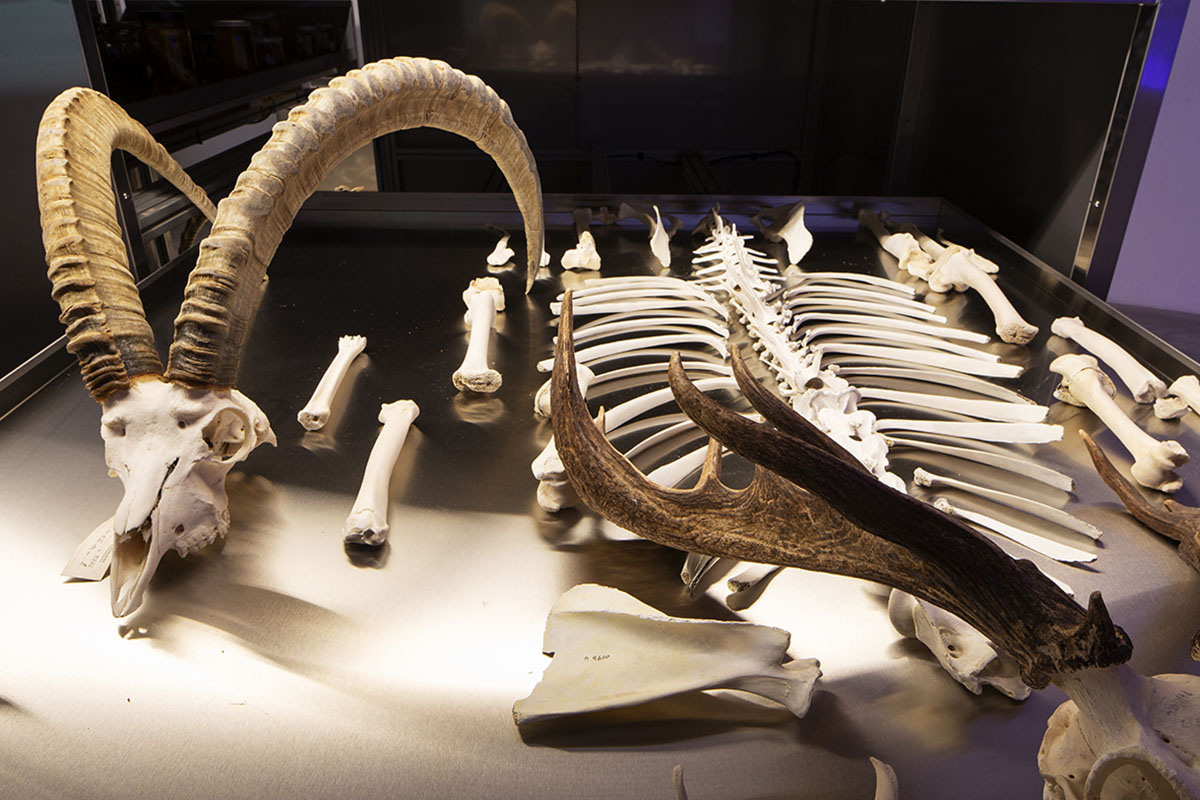Submitted by WA Contents
Israel Pavilion explores reciprocal relations between humans and animals at Venice Biennale
Italy Architecture News - Jul 02, 2021 - 15:26 6022 views

The Israel Pavilion has put animal remains, ancient human bones and skulls on display at its exhibition for the 2021 Venice Architecture Biennale, opened to the public on 22 May in Venice, Italy.
The exhibition, themed as Land. Milk. Honey, looks at the results of intensive mechanized agriculture and the manipulation of animal bodies into food-producing machines, which caused irreversible threats and damage on natural habitats, the local fauna and flora, as well as the disruption of human ways of living.

Image © Francesco Galli, courtesy of La Biennale di Venezia
Commissioned by Michael Gov, Arad Turgeman, the exhibition is curated by Dan Hasson, Iddo Ginat, Rachel Gottesman, Yonatan Cohen and Tamar Novik.

Image © Matteo Losurdo
The aim of the exhibition is examine the reciprocal relations between humans, animals, and the environment within the Israeli context.
"Our point of departure is the biblical imagery of milk and honey as a metaphor for plenitude, and its construction in practice as a Zionist project of modernisation," said the curators.

Image © Matteo Losurdo
The exhibition focuses on five animals, domesticated and wild, each representing the multifaceted narrative of the introduction of modernity to the Levant.
The exhibition is based on five case studies with cows, goats, honey bees, water buffaloes, and bats. All these animals, part of the analysis, show how the multipartite elements of exploitation and the results of modernity have impacted the local fauna and flora in the region.

Image © Matteo Losurdo
The team reflected a spatial history of a place in five acts: Mechanisation; Territory; Cohabitation; Extinction, and Post-Human.
Presented like science lab, the exhibition frames significant environmental changes experienced in Palestine-Israel during the twentieth century. The Israel Pavilion aims to investigate these changes and their reflections into a physical environment while merging architecture, local economy, human presence and science together.

Image © Francesco Galli, courtesy of La Biennale di Venezia
Combined with a series of artifacts from the history, the exhibition is enhanced with archival photography, videos, short films, models and a dedicated sound installation, which are all interwoven together to make feel the impacts of agriculture and land.
The curatorial statement emphasized that: "the environment was reshaped by urbanization, infrastructural projects, mechanized agriculture, intensive afforestation, and the manipulation of animal bodies into food-producing machines."

Image © Francesco Galli, courtesy of La Biennale di Venezia
"The preference of yield and the transformation of the land came at the cost of irreparable damage to natural habitats and to the local fauna and flora, as well as the disruption of human ways of living."
"Our zoocentric exhibition offers a sober look at a land radically transformed by the combined powers of ideology and technology, and emphasizes the need to establish a new contract between humans, animals and the environment, thus addressing the Biennale Architettura 2021’s key theme – How will we live together?."

Image © Francesco Galli, courtesy of La Biennale di Venezia
"Our protagonists are animals, both wild and domesticated," added a statement.
"The history of the dairy industry, for example, demonstrates the ways in which the bioengineering of animals and their living spaces had served the enterprise of constructing plenitude in Palestine-Israel – the literal realization of the biblical promise of a land flowing with milk and honey."
"Crossbreeding of Middle Eastern cows with European bulls gained prominence in the first half of the 20th century. This so-called “Hebrew Cow” emerged as a symbol of abundance and success in settling the lands of the East."

Image © Francesco Galli, courtesy of La Biennale di Venezia

Image © Francesco Galli, courtesy of La Biennale di Venezia

Image © Francesco Galli, courtesy of La Biennale di Venezia

Image © Francesco Galli, courtesy of La Biennale di Venezia

Image © Francesco Galli, courtesy of La Biennale di Venezia
The 17th International Architecture Exhibition in Venice has opened to the public on 22 May 2021. The exhibition will be on view till 21 November 2021.
This year’s architecture biennale is themed as "How will we live together?" by the curator Hashim Sarkis, the theme explores a widening context that helps architects to "imagine spaces in which we can generously live together".
We invite our readers to find out WAC's detailed coverage about the 2021 Venice Architecture Biennale on our Italy page.
Israel Pavilion "Land. Milk. Honey" exhibition facts
Commissioned by: Israel Ministry of Culture and Sport - Museums and Visual Arts Department, Israel Ministry of Foreign Affairs -Cultural Diplomacy Bureau
Commissioners: Michael Gov, Arad Turgeman
Curators: Dan Hasson, Iddo Ginat, Rachel Gottesman, Yonatan Cohen and Tamar Novic
Exhibitors: Netta Laufer, Shadi Habib Allah, Aviad Bar-Ness, Gili Marin, Adam Havkin, Daniel Meir, Apollo Legisamo, and Sarale Gur Lavi
Top image © Matteo Losurdo
> via Land. Milk. Honey
